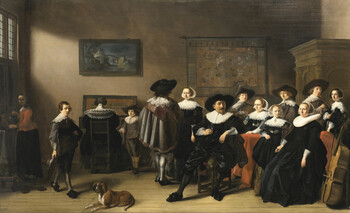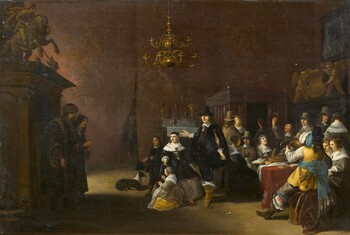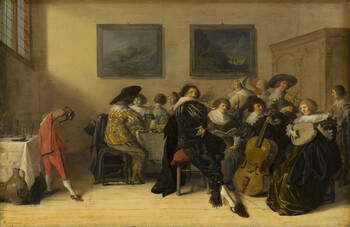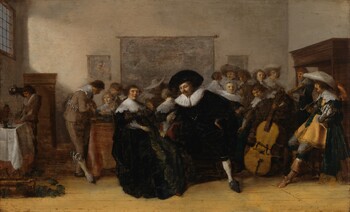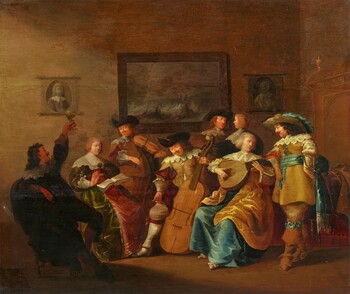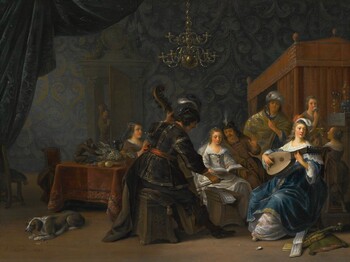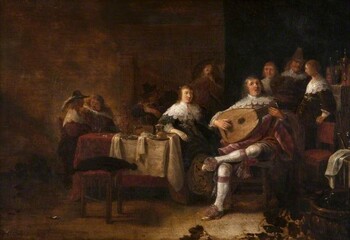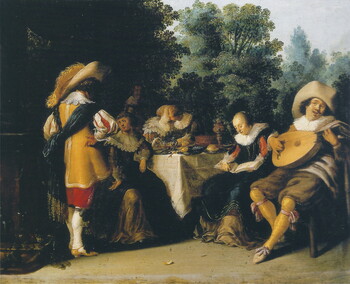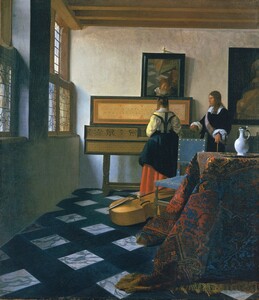15.000 €
Elegant company making music in an interior
Oil on panel : 51,8 X 73,9 cm
Unsigned
Circa 1630/1635
Frame : 76,7 X 99,1 cm
Provenance :
- New York, New York Historical Society, Inv.Nr. 1872.016
- sold at Sotheby’s New York, 12/01/95 for 9.040 $ (+ buyer’s premium) = 7.394 € (+ buyer’s premium)
- Sold after cleaning at Christie’s London, 4/07/97 for 14.950 £ = 22.769 €
In short
Anthonie Palamedesz. was an important Dutch painter of interior scenes in Delft. He often painted upper class interior scenes with one of the figures playing an instrument, regularly a mandoline. In only two or three cases a lady is playing a virginal; these paintings also date from the 1630s.
A few decades later Johannes Vermeer, who also lived in Delft, painted in the early 1670s three representations of ladies at the virginals. In the early 1660s he had already painted a larger interior scene with a man listening to a woman playing the same instrument.
About Anthonie Palamedesz.
Dutch painter
Delft 1601 – 1673 Amsterdam
Genre and portrait painter. He often painted interior scenes, especially elegant companies and guard room scenes.
Anthonie Palamedesz. also regularly painted the staffage in landscapes and architectural scenes by other painters.
He was nicknamed “Stevers” after his father’s last name, Stevaert.
He was the older brother of the battle scene painter Palamedes Palamedesz. (1607 – 1638).
Arnold Houbraken (1660 – 1719) published in 1718 his famous “De groote schouburgh der Nederlantsche konstschilders en schilderessen”, a biography of all important Dutch painters. The major part of his text on Palamedes Palamedesz. and his brother Anthonie he apparently “borrowed” from an earlier book, “Beschryvinge der Stadt Delft” by Dirck Evertsz. van Bleyswijck. This future burgomaster of Delft was only 17 years old when he published in 1667 this description of his hometown and the greatest accomplishments of its citizens.
According to van Bleyswijck Palamedes Stevaert, the father of Anthonie and Palamedes Palamedesz., was a gem-cutter and sculptor from Delft who carved semi-precious stones (jasper, porphyry, agate, etc.) into vases and other decorative art. This father was of Flemish origin; he must have been one of those many Protestants who fled from Flanders and its Spanish Inquisition to Holland.
Van Bleyswijck further tells that our painters’ younger brother, Palamedes, was born while his father was at the service of King James VI of Scotland (1566 – 1625). Shortly after Palamedes’ birth he returned with his family to Delft. Van Bleyswijck mentions James as king of Scotland (which he actually became at the age of thirteen months in 1567), so it is possible that Palamedes was born in Scotland.
On the other hand we should mention that James VI, this time under the name of James I, became also king of England and Ireland in 1603; in 1607 Palamedes must therefore have been born in London instead of in Edinburgh.
Anthonie’s teacher is unknown, but it has been speculated that he may have studied in Delft with the court painter Michiel van Mierevelt and/or Hendrick Pot, who was in the city in 1620.
Palamedesz. joined the Delft Guild of St Luke in 1621 and was head man in 1653 and 1673.
He taught Ludolph de Jongh (1616-1679) and his younger brother Palamedes Palamedesz.
Jacob Fransz van der Merck, Jacob Jansz van Velsen and Abraham Evertsz. van Westervelt were influenced by him.
He had three children by his first marriage in 1630 to Anna Joosten van Hoorendijk (she died in1651) and a son by his second marriage in 1660 to Aagje Woedewart.
In 1673 Anthonie was residing in Amsterdam, probably with his eldest son, the painter Palamedes Palamedesz. II (1633–1705), when he died.
About the origin of the last name “Palamedesz.”
In 17th century Holland the “z.” at the end of a last name stands for “zoon”, “son”. The exact pronunciation of our painters’ last name is therefore “Palamedeszoon”, meaning “the son of Palamedes”, which was the first name of Anthonie’s father.
According to the Pseudo-Apollodorus (1st or 2nd century AD) in his “Epitome” (the fourth book of the “Bibliotheca”) Palamedes was the name of the Greek hero who proved Ulysses’ madness, which he feigned so that he would not have to participate in the War of Troy, was fictitious by threatening to kill his only son Telemachus:
“ But he, not wishing to go to the war, feigned madness. However, Palamedes, son of Nauplius, proved his madness to be fictitious; and when Ulysses pretended to rave, Palamedes followed him, and snatching Telemachus from Penelope's bosom, drew his sword as if he would kill him. And in his fear for the child Ulysses confessed that his madness was pretended, and he went to the war.” (Epitome III, 7)
Ulysses never forgave Palamedes and at the end of the Trojan War he falsely accused him of treason and had him stoned to death.
In 1625 the famous Dutch author Joost van den Vondel wrote a tragedy based on this story: “Palamedes oft Vermoorde onnoselheyd” (Palamedes or the murdered stupidity).
About our painting
Anthonie Palamedesz. painted many elegant companies, set in rich interiors. Regularly one of the guests is playing an instrument, such as a mandoline.
In our painting a lady is playing a virginal, a gentleman, seen from the back, is playing a double bass and another lady is singing.
I know of only one or two other paintings where Palamedesz. represented a lady playing the virginal. Both date from the 1630s. The attribution of the second painting was changed in 2015 into Pieter Codde.
A few decades later, Johannes Vermeer painted four ladies, two seated, two standing at the virginal: the first one dates from the early 1660s, the other three from the start of the 1670s.
Our painting was part since 1872 of the collection of New York’s eldest museum, the New York Historical Society at Central Park West. It was deaccessioned in 1995, and after cleaning sold again in 1997. It sat in a French private collection.
Why should you buy this painting?
Because the representation of a lady playing the virginal is a very rare and sought-after subject. Here one really sees the instrument, which is not the case in the two other paintings by Palamedesz.
Comparative paintings
Click photos for more details

